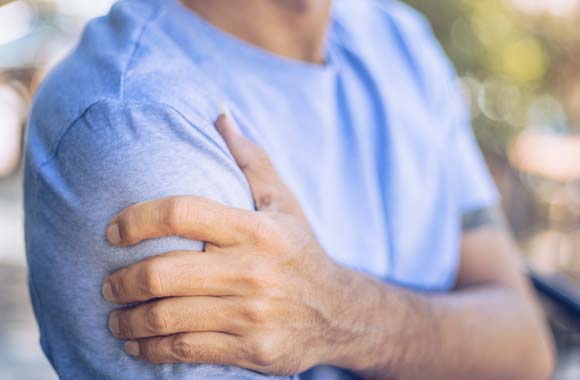Shoulder pain can arise from the shoulder joint itself or from any of the many surrounding muscles, ligaments, or tendons. Shoulder pain that comes from the joint usually worsens with activities or movement of your arm or shoulder.
To support this intricate joint, the shoulder holds several important structures and bones, such as:
- Rotator cuff: collection of muscles and tendons that surround the shoulder, enabling a vast range of motion
- Bursa: small sac of fluid that protects the rotator cuff’s tendons
- Labrum: cup of cartilage that encircles the humerus to help keep the “ball” in place
- Scapula: shoulder blade containing the coracoid, the acromion, the spine, and glenoid cavity
- Clavicle: also known as the collarbone

Common Shoulder Conditions
Due to the complex nature of the joint, the shoulder is prone to a range of uncomfortable conditions. Athletes who compete in sports that require repetitive overhead motions, like tennis and volleyball, are especially susceptible to developing pain in their shoulders. Some common shoulder conditions include:
Shoulder Instability
Shoulder instability encompasses a variety of conditions as it occurs when the ligaments or tendons in the shoulder joint become stretched, torn, or detached. Shoulder instability can result from shoulder dislocations, labral tears, rotator cuff tears, genetic conditions, and more.
Labral Tear
The labrum is a ring of cartilage that contributes to shoulder stability by reinforcing the ball-and-socket joint. Labral tears can occur due to a traumatic injury, overuse, or the natural aging process. If injured, a torn labrum can cause a partial or complete shoulder dislocation, as well as a considerable amount of pain. There are two kinds of labral tears:
- Superior labrum from anterior to posterior (SLAP)
- Bankart tear
Rotator Cuff Tear
The rotator cuff is a group of muscles and tendons that form a cuff over the shoulder joint, keeping the arm in its socket and enabling the joint a wide range of motion. In a rotator cuff tear, the muscles and tendons are either partially or entirely ripped away from the bone. Partial-thickness or full-thickness tears can occur in two ways:
- Acute tear
- Degenerative tear
Shoulder Tendonitis
Shoulder tendonitis is the inflammation of a tendon that commonly develops as a result of repetitive use, a sports injury, or sudden, acute trauma to the region. In the shoulder, tendonitis usually occurs from being pinched by nearby structures. Tendonitis can cause limited mobility, soreness, and pain in the affected area.
Frozen Shoulder
A frozen shoulder is characterized by a gradual loss of movement and happens when the capsule of connective tissue in your shoulder thickens and tightens around the joint. The exact cause of a frozen shoulder is unknown, but your risk of developing a frozen shoulder increases if your shoulder is immobilized for an extended period of time, such as after a surgical procedure. There are three stages to a frozen shoulder:
- Freezing
- Frozen
- Thawing
Shoulder Separation (AC Dislocation)
A shoulder separation, also known as an acromioclavicular separation, is a type of injury where the clavicle separates from the scapula. This injury commonly happens as a result of a sudden, traumatic incident, usually a direct blow to the shoulder or a fall on an outstretched arm.
Shoulder Dislocation
A shoulder dislocation differs from a shoulder separation in that the head of the humerus pops out of its normal position in the scapula. In simpler terms, the ball of the joint falls out of its socket. Since the shoulder has a wide range of mobility, it can dislocate forwards, backwards, or downwards, and it can also completely dislocate or partially dislocate. A dislocated shoulder may be caused by sports injuries, acute trauma, or a fall.
Treatment Options for Shoulder Conditions
Non-surgical treatment options include:
- Physical therapy
- RICE: Rest, Ice, Compression, and Elevation
- Corticosteroid and other types of injections
- Over-the-counter pain relievers
Some shoulder conditions, including those that do not respond to conservative measures, may require surgery. At Motion Orthopaedics, our surgeons are experts in the following types of surgery:
- Arthroscopy: minimally invasive technique to manage soft tissue disorders such as rotator cuff tears, labral injuries, instability, and stiffness.
- Arthroplasty: partial shoulder replacement, total shoulder replacement, and reverse shoulder replacement.
- Fracture fixation of the shoulder including clavicle and proximal humerus.











